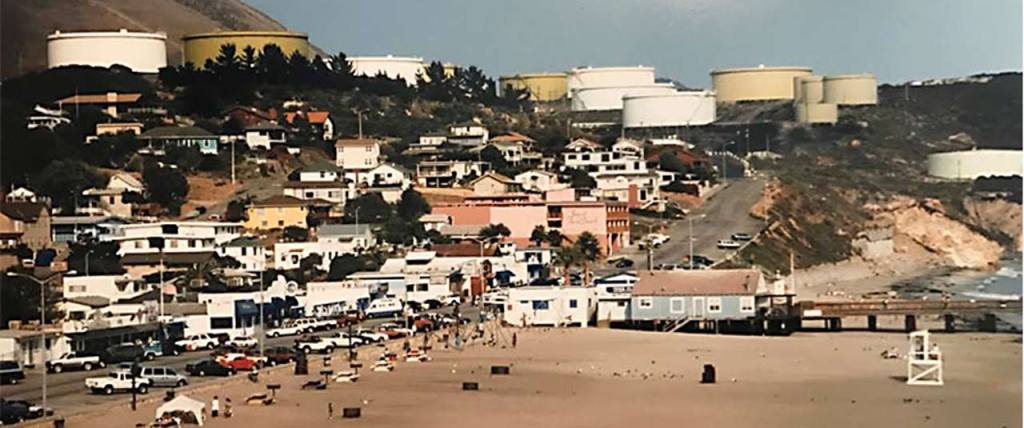Written by Avila Beach Golf Resort on 26 September 2018
Black Gold Boomtown: The Origins of Avila’s Oil Industry

Many people know how the oil industry in Avila Beach ended: with a persistent underground leak that ultimately necessitated a massive cleanup in the late 1990s.
But how did the local oil industry begin, and why was Avila Beach such a force in the California oil experience dating back to the turn of the century—to the point that Port San Luis would become the world’s largest crude oil shipping port?
The story begins in the nearby Santa Maria Valley, where oil was struck in the early 1900s. As noted in the book The Pacific Coast Railway, one well at the Santa Maria Field “created such a flow of oil that there was urgent need for an efficient means of transport.”
At the time, Port Harford—later known as Port San Luis—was a bustling epicenter of local trade, commerce and transportation, making it a perfect place for shipping the newly found “black gold” to refineries up and down the coast. The question was—how would the oil get to the port in the first place? At the time, the narrow-gauge Pacific Coast Railway “had no tank cars to handle this bonanza.” However, with necessity being the mother of invention, railway workers managed to remount standard-gauge rail tanks onto narrow-gauge flatcars. Meanwhile, the Pacific Coast Oil Company installed a holding tank at Port Harford to store the oil delivered by the railway. Soon enough, Port Harford was in the oil business.
The Union Oil Company, owner of the Santa Maria Field, used “old sailing ships” for oil transport. These ships would be filled with crude then towed by steamships. As the aforementioned book noted, “The barkentine Fullerton was once towed from California to Hawaii with 16,000 barrels of oil in her hold.”
Additionally, with new oil strikes happening right here in San Luis Obispo County, drilling machinery was being shipped to Port Harford and transported inland on the railway.
By June 29, 1904, The San Luis Obispo Morning Tribune was calling it a local “oil boom,” noting that the “special oil train” was delivering “nine or ten cars of oil daily to the Pacific Coast Oil Company at Port Harford. Fifteen new oil cars have been ordered, the last of which are expected to arrive within two weeks.”
Then, as local historian Daniel Krieger wrote, “Refinery operations began in Avila in 1908. The little village soon resembled a smaller version of Wilmington or Oleum. Oil was the major employer and most activities were of an industrial nature.”
A concentration of so much oil was not without its dangers. On January 27, 1908, lightning struck one of the tanks at the Union Oil Company tank farm on the bluffs above Avila Beach. The oil within was ignited, and massive black plumes billowed skyward. The fire spread to other tanks, one of which exploded. It took two days to get the conflagration under control.
But the oil boom showed no signs of abating. In 1914, the Pacific Coast Railway constructed a new commercial pier the between Avila Beach Village and Port Harford. Oil could now be shipped from both the Harford pier and the new railway pier. It was during this period that Avila Beach laid claim to being the world’s largest oil-shipping port.
In 1923, Harford Pier stopped shipping oil, and thereafter all oil out of San Luis Bay was shipped from the railway pier. After leasing the railway pier for many years, Union Oil purchased it outright in 1941 and renamed it the Union Oil Pier. As late as the early 1990s, massive oil tankers would routinely dock at the end of the oil pier, creating a sight to behold. The pier now belongs to Cal Poly’s Center for Coastal Marine Sciences, having been donated to the university in 2001.
While it may be hard to believe today, there was indeed a time when Avila Beach was dominated by the oil industry. As you look up at the beachfront bluffs that were once dominated by oil tanks, and out to the end of the Cal Poly pier where the massive tankers once loomed, you can almost imagine the bygone era of black gold in Avila Beach.
# # #
Sources: An Industrial Village on The Pacific Coast by Daniel E. Krieger, Ph. D.; “History of The Pier” by Cal Poly’s Center for Coastal Marine Sciences; “History of Avila Beach and Port San Luis” by Port San Luis Harbor District and San Luis Obispo County History Center; The Pacific Coast Railway by Kenneth E. Westcott and Curtiss H. Johnson; “Oil Tank Farm in Avila Beach Burned…” by David Middlecamp for the San Luis Obispo Tribune.

